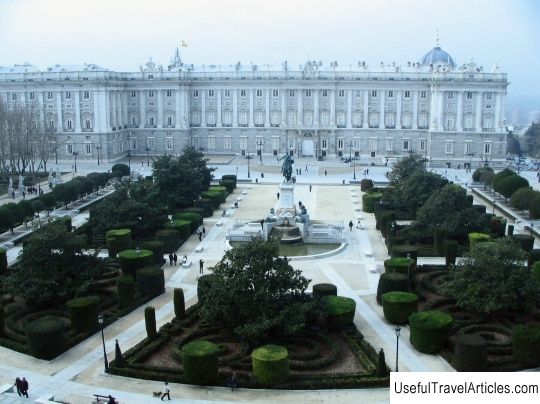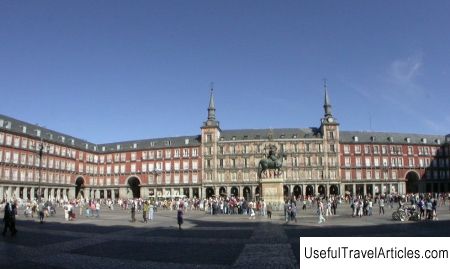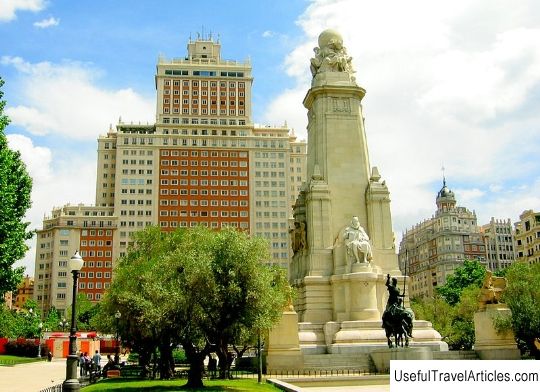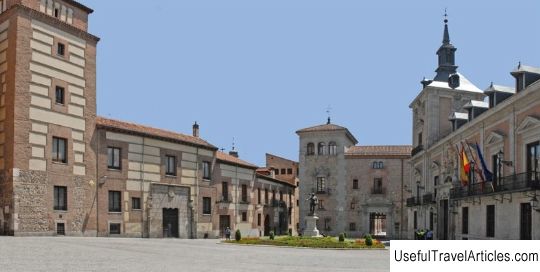Plaza de Oriente description and photos - Spain: Madrid

Plaza de Oriente description and photos - Spain: Madrid. Detailed information about the attraction. Description, photographs and a map showing the nearest significant objects. The title in English is Plaza de Oriente. Photo and descriptionThe famous East Square is located in the historic center of Madrid, between the majestic Royal Palace and the Royal Theater. It is due to the fact that it is located on the east side of the Royal Palace that the square got its name. On the north side of the square adjoins the Royal Monastery of the Resurrection - Encarnacion, surrounded by a small green park. The construction of the Eastern Square was started during the reign of Joseph Bonaparte, and ended under Queen Isabella II. The main concept of the square ensemble belongs to the architect Juan Bautista Sacchetti. In order to free up the territory for the construction of the square, a number of buildings in this place were demolished and the relief of the land was leveled. In the center of the square is a magnificent statue of King Philip IV on horseback. This equestrian sculpture was created by the famous sculptor Pietro Tacca in 1640, based on the portrait of the king by the great Velazquez. By order of Queen Isabella, the statue was moved and installed in East Square. This sculpture is recognized as the first monument in the world depicting a horse, standing only on its hind legs. The monument to Philip IV is surrounded by large green squares. The originally laid out squares were rebuilt in 1941, and since then they have been located around the square-shaped monument. Among the greenery of the squares are 20 statues of Spanish monarchs, which are arranged in chains to the left and right of the central monument. depicting King Philip IV on horseback. This equestrian sculpture was created by the famous sculptor Pietro Tacca in 1640, based on the portrait of the king by the great Velazquez. By order of Queen Isabella, the statue was moved and installed in East Square. This sculpture is recognized as the world's first monument depicting a horse, standing only on its hind legs.The monument to Philip IV is surrounded by large green squares. The originally laid out squares were rebuilt in 1941, and since then they have been located around the square-shaped monument. Among the greenery of the squares are 20 statues of Spanish monarchs, which are arranged in chains to the left and right of the central monument. depicting King Philip IV on horseback. This equestrian sculpture was created by the famous sculptor Pietro Tacca in 1640, based on the portrait of the king by the great Velazquez. By order of Queen Isabella, the statue was moved and installed in East Square. This sculpture is recognized as the world's first monument depicting a horse, standing only on its hind legs.The monument to Philip IV is surrounded by large green squares. The originally laid out squares were rebuilt in 1941, and since then they have been located around the square-shaped monument. Among the greenery of the squares are 20 statues of Spanish monarchs, which are arranged in chains to the left and right of the central monument. which took as a basis the portrait of the king, made by the great Velazquez. By order of Queen Isabella, the statue was moved and installed in East Square. This sculpture is recognized as the world's first monument depicting a horse, standing only on its hind legs.The monument to Philip IV is surrounded by large green squares. The originally laid out squares were rebuilt in 1941, and since then they have been located around the square-shaped monument. Among the greenery of the squares are 20 statues of Spanish monarchs, which are arranged in chains to the left and right of the central monument. which took as a basis the portrait of the king, made by the great Velazquez. By order of Queen Isabella, the statue was moved and installed in East Square. This sculpture is recognized as the world's first monument depicting a horse, standing only on its hind legs.The monument to Philip IV is surrounded by large green squares. The originally laid out squares were rebuilt in 1941, and since then they have been located around the square-shaped monument. Among the greenery of the squares are 20 statues of Spanish monarchs, which are arranged in chains to the left and right of the central monument. The monument to Philip IV is surrounded by large green squares. The originally laid out squares were rebuilt in 1941, and since then they have been located around the square-shaped monument. Among the greenery of the squares are 20 statues of Spanish monarchs, which are arranged in chains to the left and right of the central monument. The monument to Philip IV is surrounded by large green squares. The originally laid out squares were rebuilt in 1941, and since then they have been located around the square-shaped monument. Among the greenery of the squares are 20 statues of Spanish monarchs, which are arranged in chains to the left and right of the central monument.       We also recommend reading Chetham's Library description and photos - Great Britain: Manchester Topic: Plaza de Oriente description and photos - Spain: Madrid. |




